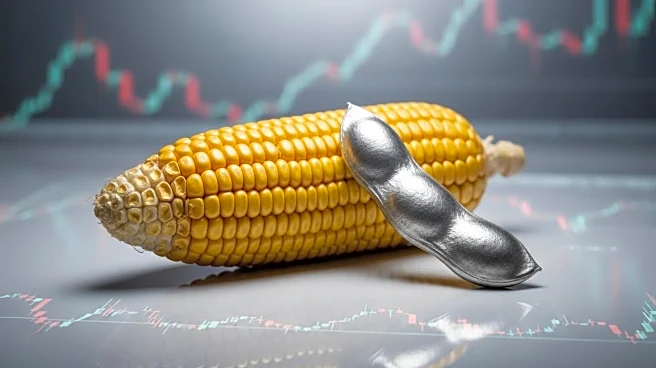What is the story about?
What's Happening?
Grain and soybean trading is closed for Labor Day, with trading set to resume in the overnight session. According to the Commodity Futures Trading Commission (CFTC), investors have turned bullish on soybeans, shifting from a net-short position of 1,753 contracts to a net-long position of 19,145 futures contracts. This marks the most bullish stance since June 24. Meanwhile, money managers have reduced their net-short positions in corn futures, marking the smallest such position since May 27. Hedge funds and other large investment firms have also adjusted their positions in hard-red and soft-red winter wheat futures. The CFTC's weekly Commitment of Traders report provides insights into trader positions in futures markets, indicating shifts in market sentiment.
Why It's Important?
The shift in investor sentiment towards soybeans and corn futures could have significant implications for agricultural markets and pricing. A bullish stance suggests expectations of higher prices, which could impact farmers, traders, and consumers. The reduction in net-short positions in corn and wheat futures may indicate a stabilization or potential increase in prices, affecting supply chain decisions and market strategies. These developments are crucial for stakeholders in the agricultural sector, including producers and investors, as they navigate market dynamics and potential price fluctuations.
What's Next?
Trading will resume after the Labor Day holiday, potentially reflecting the recent shifts in market sentiment. Stakeholders will be closely monitoring the futures markets for further changes in investor positions and price movements. Additionally, weather conditions in parts of North Dakota, Minnesota, and Iowa could impact agricultural production and market supply, influencing future trading decisions. The National Weather Service has forecasted isolated thunderstorms, hail, and heavy rainfall, which may lead to localized flooding and affect crop yields.
Beyond the Headlines
The adjustments in futures positions highlight the complex interplay between market speculation and real-world agricultural conditions. The influence of weather patterns on crop production and market supply underscores the importance of accurate forecasting and risk management strategies for farmers and investors. As climate variability continues to impact agricultural outputs, stakeholders must adapt to changing conditions and leverage data-driven insights to optimize their operations.
AI Generated Content
Do you find this article useful?
















